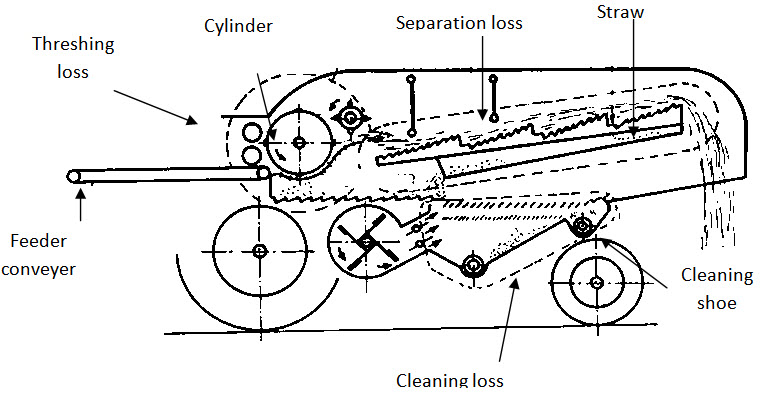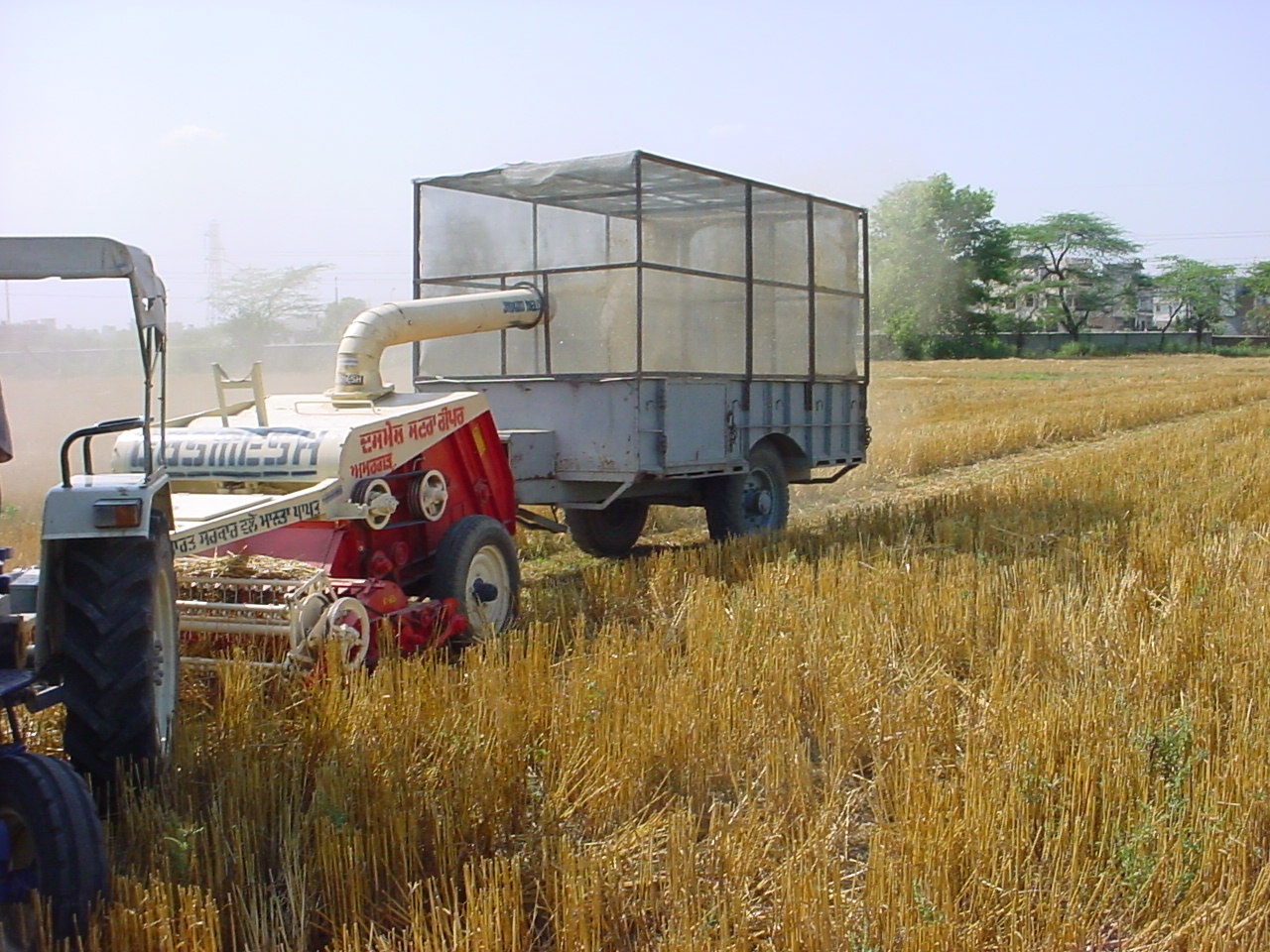Site pages
Current course
Participants
General
MODULE 1. PRINCIPLES AND TYPES OF CUTTING MECHANISM
MODULE 2. CONSTRUCTION AND ADJUSTMENT OF SHEAR AND...
MODULE 3. CROP HARVESTING MACHINERY
MODULE 4. FORAGE HARVESTING, CHOPPING AND HANLING ...
MODULE 5. THRESHING MECHANICS, TYPES OF THRESHES, ...
MODULE 6. MAIZE HARVESTING AND SHELLING EQUIPMENT
MODULE 7. ROOT CROP HARVESTING EQUIPMENT
MODULE 8. COTTON PICKING AND SUGARCANE HARVESTING ...
MODULE 9. PRINCIPLES OF FRUIT HARVESTING TOOLS AND...
MODULE 10. HORTICULTURAL TOOLS AND GADGETS
MODULE 11. TESTING OF FARM MACHINES, RELATED TEST ...
MODULE 12. SELECTION AND MANAGEMENT OF FARM MACHIN...
LESSON 12. GRAIN COMBINE LOSSES AND STRAW COMBINES
Grain losses before and during field operation of combine: There are different types of grain losses in the field before and during combining of crops. Moisture contents at the time of harvesting affects the grain losses. At low moisture content, grain losses are pre-harvest shattering loss, cutter bar loss and more breakage of grain. At low moisture the straw is broken finely by the cylinder and more material flows to the sieve resulting into separation problem. There is a risk of natural hazards like rain and hailstorm, which also leads to lodging of crop. Due to delay in harvesting, more weed growth takes place that causes choking of combine. At high moisture content, grains are badly damaged by the cylinder action. The threshing is poor and good cleaning is also a problem. This leads to higher cylinder loss and lower cleaning efficiency. The grains get struck to moist straw and are carried away with straw and chaff. There might be choking problem at different stages in the combine due to high moisture content. As per BIS the combine losses should be maximum 2.5% for wheat, paddy and gram and 4.0% for soybean (IS: 8122 Part II – 1981). Various combine losses (Fig. 1) are discussed below:

Fig. 1: Various combine loss sections on the combine harvester.
Pre-harvest loss: It is determined at minimum of three places randomly selected in the field where combine harvester is to be operated. The sample should be collected from the area having one-meter length in the direction of travel and full or half width of cutter bar of machine depending upon its size. All the loose grains, complete and incomplete ear heads fallen in the marked area have to be picked up manually without vibrating the plants before the machine is to be operated. This will give pre-harvest loss.
Header loss: It is determined on those portions of ground, which are protected from combine afflux by the use of rolls of cloth. The loose grains and complete and incomplete ear heads fallen on the marked area, where pre-harvest losses were determined, shall be collected manually. This gives the header loss. It is also called cutter bar loss.

Rack and shoe loss: For determining the rack and shoe loss, the straw and chaff afflux is collected separately. To collect these, two rolls of cloth 30 m in length and one and half times the width of straw/chaff outlet is suspended on especially attached fittings beneath the rear of machine. As the sheets of cloth unroll, one sheet retains the afflux from straw walker and other from sieve for 20 m run length. Unrolling operation starts 5 m in advance and terminates 5 m ahead of end point.

Grain crackage: It is determined from the samples taken from grain tank. Only visible damaged grains are separated and expressed in percentage of sample taken.

Expected range of losses: Losses, with the best combine adjustments, will vary greatly depending upon the type’s variety and the condition of the crop. Total losses in clean crop of wheat oats and barley will vary from 1% to 4% of total yield. Under good harvesting condition the total loss should not be more than 1.5%.
(i) Cutter bar loss - 0.5 to 2%
(ii) Cylinder loss - 0.5 to 1%
(iii) Rack loss - 0.2 to 0.4%
(iv) Shoe loss - 0.2 to 0.4%
The losses could be minimized by running the combine at proper adjustment. Setting and performance of different parameters are discussed below:
Cutting and conveying: The height of cut can be adjusted from 5 cm to 75 cm in most of the combines. The rate of feeding can be adjusted by manipulating height of cut and forward speed of machine. Forward speed range of 2.5 - 4.5 km/h for standing crop and 1 - 1.5 km/h for lodged crop has been recommended by ISI. The speed of cutter bar varies from 400 to 550 rpm.
Reel adjustment (ISI): The horizontal positioning should be such that real bats have a distance of 50 to 100 mm in front of the cutter bar. The optimum value of reel index should be 1.10 to 1.25.
Problem 1: A combine was tested for harvesting jowar and following observations were recorded:
Total area harvested = 78 sq. m.
Total time required = 65 seconds.
Total material left over the rack =18 kg.
Free seed over the rack =150 gms.
Unthreshed seed over the rack = 120 gms.
Free seed over the shoe = 530 gms.
Unthreshed seed over shoe = 150 gms.
Total material left over shoes = 8 kg.
Net grain collected in the tank = 34 kg.
Calculate:
Seed yield and total loss in kg/hectare.
Cylinder loss, rack loss, shoe loss and total grain loss as percent of total yield.
Total feed rate in kg/hour.
Rates of straw and chaff over the rack and over the shoe in kg/hr.
Percentage of straw and chaff retained by r4ack.
Solution:
1. Total area harvested = 78 m2
Total seed harvested = 150 +120 + 530 +341 =34.95 kg
So, seed yield = 34.95/78 x 104 kg/hectare = 1480 kg/ha
Total seed loss = (34.95 – 34.0)/78 x 104 kg/ha
= 121.8 kg/ha
2. Cylinder loss is the un-threshed seed discharged from the rear of the machine, either in the straw or in the material from the cleaning unit.
Total un-threshed seed = (120 +150) = 0.270 g
Total cylinder loss = (0.270 x 100)/34.95 = 0.773%
Rack loss is the free threshed seed carried over the rack in the straw and discharged from the machine.
So, rack loss = (0.150 x 100)/34.95 = 0.429%
Shoe loss is the loss of free seed carried over the rack in the straw and discharged from the machine.
So, rack loss = (0.530 x 100)/34.95 = 1.518%
Total loss of seed = 150 m + 120 m + 530 m + 150 m = 950 g = 0.95 kg
3. Total material fed including seed and straw
= 18 + 8 + 34 = 60 kg
So, feed rate = (60/65) x 60 x 60 = 3320 kg/h
4. Over the rack total material is 18 kg. Out of which free seed is 150 gm and un-threshed seed is 120 gm. So, net weight of straw in rack is
= (18-0.15-0.12) kg = 17.73 kg.
Rate of straw over rack = (17.73/65) x 60 x 60 kg/h = 982 kg/h
Similarly net weight of straw over shoe = (8-0.53-0.15) kg = 7.32 kg.
So, rate of straw over shoe = (7.32/65) x 60 x 60 = 405 kg/h
5. Percentage of straw and chaff retained on rack
={ (18-0.15-0.12)/(17.73+7.32)} x 100 = 70.9%
Straw combine
Use of grain combines has helped in timely harvesting of cereal crops and saves from huge grain losses due to bad weather during harvesting period. But, it also results in loss of straw ‘bhusa’ which is used as cattle feed in most part of the country. After harvesting of crop by grain combine, straw and stubble left in the field are burnt by most of the farmers, which leads to loss of ‘bhusa’ and environmental pollution. Straw combine (Fig. 1) is a machine that cuts and collects the stubble left behind in the field after grain harvesting and converts both of them into small pieces of straw. The machine is pulled and powered by a 45-50-hp tractor. Self-propelled straw combines are also available. The ‘bhusa’ is collected in an enclosed trailer attached behind the machine.
The machine consists of stubble cutting unit, straw collecting unit, feeding unit, straw bruising unit and straw blowing unit (Fig. 2). Three different types of straw bruising mechanisms are used in straw combine viz. spike-tooth type, chaff cutter type and serrated saws type bruising mechanism. The major components of machine are reel, cutter bar, auger, feeder, straw bruising cylinder, concave, aspirator blower, sieves and gearbox. It has cutter bar reel, feeding auger and bruising cylinder like a traditional thresher. Straw thrown and stubble left by the grain combine is collected by straw combine and delivered to the cylinder-concave section, where it is cut into pieces and passed through the concave. A reciprocating cutter bar is used for reaping the standing stubbles and the portion of the straw left uncut by the combine harvester. Straw, which passes through the concave, is aspirated by a blower and fed into a trolley on rear side covered by a wire net. For recovering the left grains from the straw, a sieve system is provided below the concave. Working capacity of straw combine is 0.4 to 0.5 ha/h and it can make ‘bhusa’ between 1.5 to 2.5 t/ha. Weight of the machine is about 1700 kg. It can recover 55-65% of straw successfully as compare to the traditional method of threshing. The fuel consumption varied from 3.5-4 l/h. There is also a recovery of 75-100 kg of grain per hectare. Overall dimensions are:
|
Overall dimensions, cm |
468 x 160 x 197 |
|
Power source |
Tractor of 35 hp and above |
|
Cutter bar width, cm |
200 |
|
Threshing cylinder type |
Cutter blade mounted on the cylinder |
|
Blower size, cm |
50 x 70 |
|
Concave opening, cm |
1.27 |
Other features of machine are:
|
Speed of operation, km/h |
4.0 |
|
Straw recovery, % |
55 - 60 |
|
Grain recovery, kg/ha |
30 |
|
Height of cut, cm |
2.0 |
|
Quality of straw |
Very good |
|
Saving as compared to traditional method |
|
|
Labour requirement, % |
60 |
|
Cost of operation, % |
33 |

Fig. 2: A view of Straw combine in field with trolley attached.
Tractor operated straw reaper with storage box mounted above straw reaper for easy turning has also been developed (Fig. 3). It has hydraulically unloading device to unload ‘bhusa’ in the field or at storage place.
